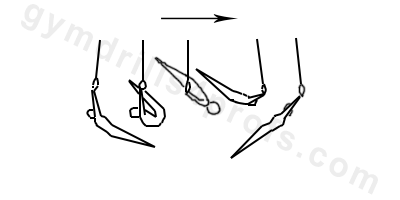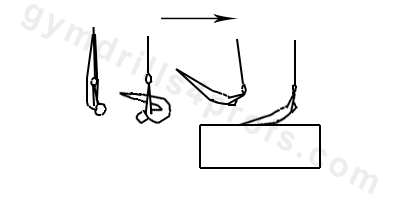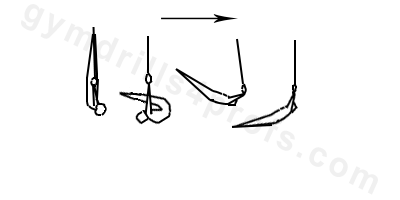


The dislocate skill is an excellent exercise to practice giant swings. Ideally, a disclocate is done with enough height and pressure on the rings so that the gymnast is able to pass through handstand above the rings. There are a few variations and progressions of the dislocate skill. The first (and easiest) is the piked dislocate, followed by the stretched dislocate and eventually giant swing. Regardless of the variation, the body should stay hollow throughout the majority of the skill until reaching the vertical position. Once the gymnast reaches this position, they should straighten their body shape slightly but avoid significant arching. The gymnast’s head should remain neutral or down in order to avoid arching from the upper back and to help maintain more pressure on the rings as they pass through vertical. As the gymnast finishes the shifting from their shoulders, they should push the rings forward and lead from their chest as they reach the bottom of the swing. At this point, they can begin to arch through the bottom of the swing in order to kick their legs and hips for acceleration. The athlete should be very familiar with maintaining a candlestick body shape and keeping pressure on the rings. A common mistake that many gymnasts make when attempting the dislocate for the first time is arching their body as they pass through vertical. This can lead to a lack of control, height, and pressure on the rings. This can be a difficult habit to break and for this reason, it’s important to emphasize the proper technique when first learning the skill. Spotting and holding the gymnast as they pass through vertical can be an effective method in teaching them the correct body positions.

At the highest point in the back swing, the shoulders should be extended with the rings going slightly sideways. The body should be in an arched position. From the top of the swing, continuous shoulder extension toward the bottom of the swing must be maintained. This helps the gymnast maintain the arched body position until the bottom of the swing. At the bottom, the gymnast should kick the legs forward and upward to make their entire body turn over as fast as possible. The gymnast should attempt to kick from their upper chest at the bottom. Shoulder should remain extended and stay down until the entire body turns over completely. The rings should be pushed backward when the gymnast’s feet are pointed towards the ceiling. The rings should turn parallel (wrists facing one another). The rings should not go sideways during this portion of the swing. The final position is a higher point of the front swing, where the body should be in a slight hollow position with arms tight and parallel. The head should be neutral with the gymnast maintaining backward pressure on the rings. From the highest point of the front swing starts the backswing. The body should swing down in a hollow position without losing pressure on the rings. At the bottom, the gymnast should initiate a strong kick off their heels. During the turnover phase, the head should stay down to facilitate a stronger heel lift. Shoulders should remain low. When their heels have risen and their toes are directed upward toward the ceiling, the rings can be slightly open, the head will be slightly elevated as well. The final position of the backswing is arched. VERY IMPORTANT: In the backswing, do not pull down on the rings. The leading motion of the move is the kick back with the heels.

The gymnast takes a wooden stick behind their back in an under grip. They raise the stick over their head and lower it in front of their body. Then they should return the stick back to the starting position. During the drill, the arms should be tight. The hands should be as close as possible.

The first part of the drill is the same as the backward roll pike. When the pushing of the arms against the floor begins, the body opens in a strong hollow. The gymnast should not attempt to reach handstand. The drill finishes in front support.

The back extension roll is a very important drill for back giants on rings, parallel bars, and high bar. It helps the gymnast to maintain a hollow body position, without leading with the hips up to handstand. At the same time, it improves their ability to push back with their arms. The skill begins in a standing position with the arms up. The gymnast should lower the upper body to the ground, the hands should almost be touching the floor. This piking position initiates the back roll. The back should be round. When the arms reach the floor, the gymnast pushes back strongly, and at the same time directs the legs up to vertical. The push back of the arms against the floor should be extremely strong and powerful. If the performance is done well, the gymnast can hand a hand hop at the end of the move during the handstand position. During the entire execution, the arms and the legs should be tight. A very common mistake is kicking up from the hips. The move should be done entirely in a hollow position with the gymnast leading their body into handstand from their toes.

The gymnast should start the drill in a candlestick position over the (resi) mat. The head of the athlete should not touch the mat (around 1-2 inches above it). Then, they should perform an inverted pike with a fast extension upward. The extension upward should be in one fast motion so that the gymnast can shift their shoulders quick enough. They should finish the drill on their belly on the mat. In the beginning, the drill should be performed with a spotter.

The next drill is similar to the previous one. The mat should be removed, and the skill should be performed on the regular rings so that the gymnast can perform a swing afterward.
Integral part of gymnastics coaching process are skill drills. They help gymnasts to learn easier and technically correct. With GYM DRILL PRO you will find variety of ideas for the most the basic gymnastics skills. There are plenty of images with skill drill progressions. It is intended to support explicitly the qualified coaches in their daily coaching business. DO NOT practice without the guidance of proper professionals.